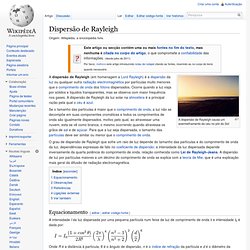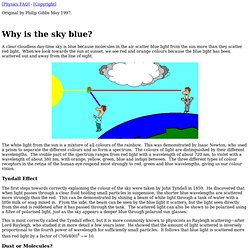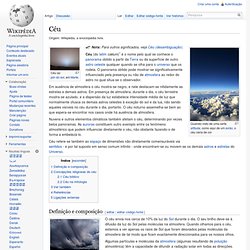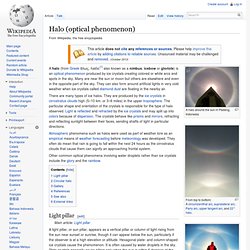

Dispersão de Rayleigh. Origem: Wikipédia, a enciclopédia livre.

A dispersão de Rayleigh causa um avermelhamento do céu no pôr do Sol Se o tamanho das partículas é maior que o comprimento de onda, a luz não se decompõe em suas componentes cromáticas e todos os comprimentos de onda são igualmente dispersados, motivo pelo qual, ao atravessar uma nuvem, esta se vê como branca; o mesmo ocorrendo quando atravessa os grãos de sal e de açúcar. Para que a luz seja dispersada, o tamanho das partículas deve ser similar ou menor que o comprimento de onda. Why is the sky Blue? [Physics FAQ] - [Copyright] Original by Philip Gibbs May 1997.

A clear cloudless day-time sky is blue because molecules in the air scatter blue light from the sun more than they scatter red light. When we look towards the sun at sunset, we see red and orange colours because the blue light has been scattered out and away from the line of sight. The white light from the sun is a mixture of all colours of the rainbow. This was demonstrated by Isaac Newton, who used a prism to separate the different colours and so form a spectrum. Tyndall Effect The first steps towards correctly explaining the colour of the sky were taken by John Tyndall in 1859.
Céu. Origem: Wikipédia, a enciclopédia livre.

Quando visto de uma certa altitude, como aqui de um avião, o céu varia de cor Em ausência de atmosfera o céu mostra-se negro, e nele destacam-se nitidamente as estrelas e demais astros. Em presença de atmosfera, durante o dia, o céu terrestre mostra-se azulado, e a dispersão da luz estabelece intensidade média de luz que normalmente ofusca os demais astros celestes à exceção do sol e da lua, não sendo aqueles visíveis no céu durante o dia, portanto. O céu noturno assemelha-se bem ao que espera-se encontrar nos casos onde há ausência de atmosfera. Nuvens e outros elementos climáticos também afetam o céu, determinando por vezes belos panoramas. Céu refere-se também ao espaço de dimensões não diretamente comensuráveis via sentidos - e por tal suposto em senso comum infinito - onde encontram-se ou movem-se os demais astros e estrelas do Universo. Definição e composição[editar | editar código-fonte] Céu turbulento Imagem tirada entre as árvores Referências.
Cone (célula) Origem: Wikipédia, a enciclopédia livre.

A estrutura celular da retina. À direita, 1 cone entre dois grupos de bastonetes Cones são as células do olho dos animais que tem a capacidade de reconhecer as cores, segundo a teoria tricromática (teoria de Young-Helmholtz). Já os bastonetes, outro tipo de célula dos olhos, tem a capacidade de reconhecer a luminosidade. Existem aproximadamente 6 milhões de cones em cada olho humano concentrados na região fóvea. Os seres humanos normalmente têm três tipos de cones. Horizonte. Origem: Wikipédia, a enciclopédia livre.

Horizon. The horizon (or skyline) is the apparent line that separates earth from sky, the line that divides all visible directions into two categories: those that intersect the Earth's surface, and those that do not.

Horizon. The horizon (or skyline) is the apparent line that separates earth from sky, the line that divides all visible directions into two categories: those that intersect the Earth's surface, and those that do not.

At many locations, the true horizon is obscured by trees, buildings, mountains, etc., and the resulting intersection of earth and sky is called the visible horizon. When looking at a sea from a shore, the part of the sea closest to the horizon is called the offing.[1] The word horizon derives from the Greek "ὁρίζων κύκλος" horizōn kyklos, "separating circle",[2] from the verb ὁρίζω horizō, "to divide", "to separate",[3] and that from "ὅρος" (oros), "boundary, landmark".[4] Appearance and usage[edit] Historically, the distance to the visible horizon at sea has been extremely important as it represented the maximum range of communication and vision before the development of the radio and the telegraph.
Distance to the horizon[edit] Examples: With d in miles[6] and h in feet, Www.fap.if.usp.br/~akerr/texto_luz.pdf. Halo (optical phenomenon) A halo around the sun in Padang, Indonesia A halo (from Greek ἅλως, halōs;[1] also known as a nimbus, icebow or gloriole) is an optical phenomenon produced by ice crystals creating colored or white arcs and spots in the sky.

Many are near the sun or moon but others are elsewhere and even in the opposite part of the sky. They can also form around artificial lights in very cold weather when ice crystals called diamond dust are floating in the nearby air. Atmospheric phenomena such as halos were used as part of weather lore as an empirical means of weather forecasting before meteorology was developed. They often do mean that rain is going to fall within the next 24 hours as the cirrostratus clouds that cause them can signify an approaching frontal system.